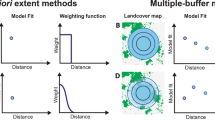Abstract
Multivariate clustering based on fine spatial resolution maps of elevation, temperature, precipitation, soil characteristics, and solar inputs has been used at several specified levels of division to produce a spectrum of quantitative ecoregion maps for the conterminous United States. The coarse ecoregion divisions accurately capture intuitively-understood regional environmental differences, whereas the finer divisions highlight local condition gradients, ecotones, and clines. Such statistically generated ecoregions can be produced based on user-selected continuous variables, allowing customized regions to be delineated for any specific problem. By creating an objective ecoregion classification, the ecoregion concept is removed from the limitations of human subjectivity, making possible a new array of ecologically useful derivative products. A red–green–blue visualization based on principal components analysis of ecoregion centroids indicates with color the relative combination of environmental conditions found within each ecoregion. Multiple geographic areas can be classified into a single common set of quantitative ecoregions to provide a basis for comparison, or maps of a single area through time can be classified to portray climatic or environmental changes geographically in terms of current conditions. Quantified representativeness can characterize borders between ecoregions as gradual, sharp, or of changing character along their length. Similarity of any ecoregion to all other ecoregions can be quantified and displayed as a “representativeness” map. The representativeness of an existing spatial array of sample locations or study sites can be mapped relative to a set of quantitative ecoregions, suggesting locations for additional samples or sites. In addition, the shape of Hutchinsonian niches in environment space can be defined if a multivariate range map of species occurrence is available.
Similar content being viewed by others
Author information
Authors and Affiliations
Corresponding author
Rights and permissions
About this article
Cite this article
Hargrove, W.W., Hoffman, F.M. Potential of Multivariate Quantitative Methods for Delineation and Visualization of Ecoregions. Environmental Management 34 (Suppl 1), S39–S60 (2004). https://doi.org/10.1007/s00267-003-1084-0
Published:
Issue Date:
DOI: https://doi.org/10.1007/s00267-003-1084-0




